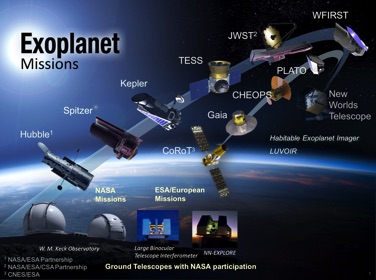As more transits of the TRAPPIST-1 planets are measured, the light curves will be refined, especially for distant TRAPPIST-1h. The edges of the dips in light can indicate whether an atmosphere is present. A sharp drop and rise suggests a hard edge to the planet, indicating either no atmosphere, or one very opaque to light. A gradual slope is indicative of an atmosphere that dims the light before cutting it off. Spectra taken of the dimmed light can capture signatures of chemicals and compounds in the atmosphere. Scientists are especially interested in detecting oxygen and other elements produced by life, or chemical compounds emitted by the industrial output of an advanced civilization.
In 2018, the successor to the Hubble Space Telescope – the James Web Space Telescope (JWST) - will be launched into orbit. This telescope will gather about six times more light than Hubble, with finer resolution and at infrared wavelengths of light well suited for studying the atmospheres of exoplanets and detecting the chemical fingerprints of life.
NASA’s Transiting Exoplanet Survey Satellite (TESS), expected to also launch in 2018, is a space telescope designed to search for exoplanets using the transit method. The primary mission will see TESS survey the brightest stars near the Earth for transiting exoplanets over a two-year period.
The Starshade Project is a proposal that will use two spacecraft – one a specially shaped occulting disk, reminiscent of a lotus flower, and the other a space telescope, to hide distant stars’ direct light, while orbiting exoplanets are imaged directly. It will enable spectra of planetary atmospheres to be measured, free of the primary star’s light.
The hunt for exoplanets is entering an exciting new phase of discovery. It is possible that within our lifetime, we might finally answer the question – are we alone in the universe?
